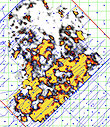Engineers have successfully sequestered 11 million tons of carbon dioxide — equivalent to the annual CO2 releases from five medium-sized coal-fired power plants — in an underground limestone formation in Canada. The Geological Survey of Canada says that the CO2 has been pumped more than a mile underground at the site of two former oilfields in Saskatchewan. Using seismic technology, scientists have been able to trace the subterranean spread of CO2 as it seeped into limestone formations over an area of 8-square-miles. (See image to the left.) The seismic technology has enabled them to ensure that the CO2 is not leaking back into the atmosphere, which would not only defeat the purpose of locking away greenhouse gases underground but could also pose a danger to humans.
Test of CO2 Sequestration Is Successful on Large Scale in Canada
More From E360
-
WATER
After Ruining a Treasured Water Resource, Iran Is Drying Up
-
FILM
At a Marine Field Station, Rising Seas Force an Inevitable Retreat
-
Energy
To Feed Data Centers, Pennsylvania Faces a New Fracking Surge
-
SPACE
Scientists Warn of Emissions Risks from the Surge in Satellites
-
WILDLIFE
A Troubling Rise in the Grisly Trade of a Spectacular African Bird
-
MINING
In Myanmar, Illicit Rare Earth Mining Is Taking a Heavy Toll
-
INTERVIEW
How Batteries, Not Natural Gas, Can Power the Data Center Boom
-
ANALYSIS
As U.S. and E.U. Retreat on Climate, China Takes the Leadership Role
-
Solutions
From Ruins to Reuse: How Ukrainians Are Repurposing War Waste
-
ANALYSIS
Carbon Offsets Are Failing. Can a New Plan Save the Rainforests?
-
Energy
Facing a Hostile Administration, U.S. Offshore Wind Is in Retreat
-
Biodiversity
As Jaguars Recover, Will the Border Wall Block Their U.S. Return?
